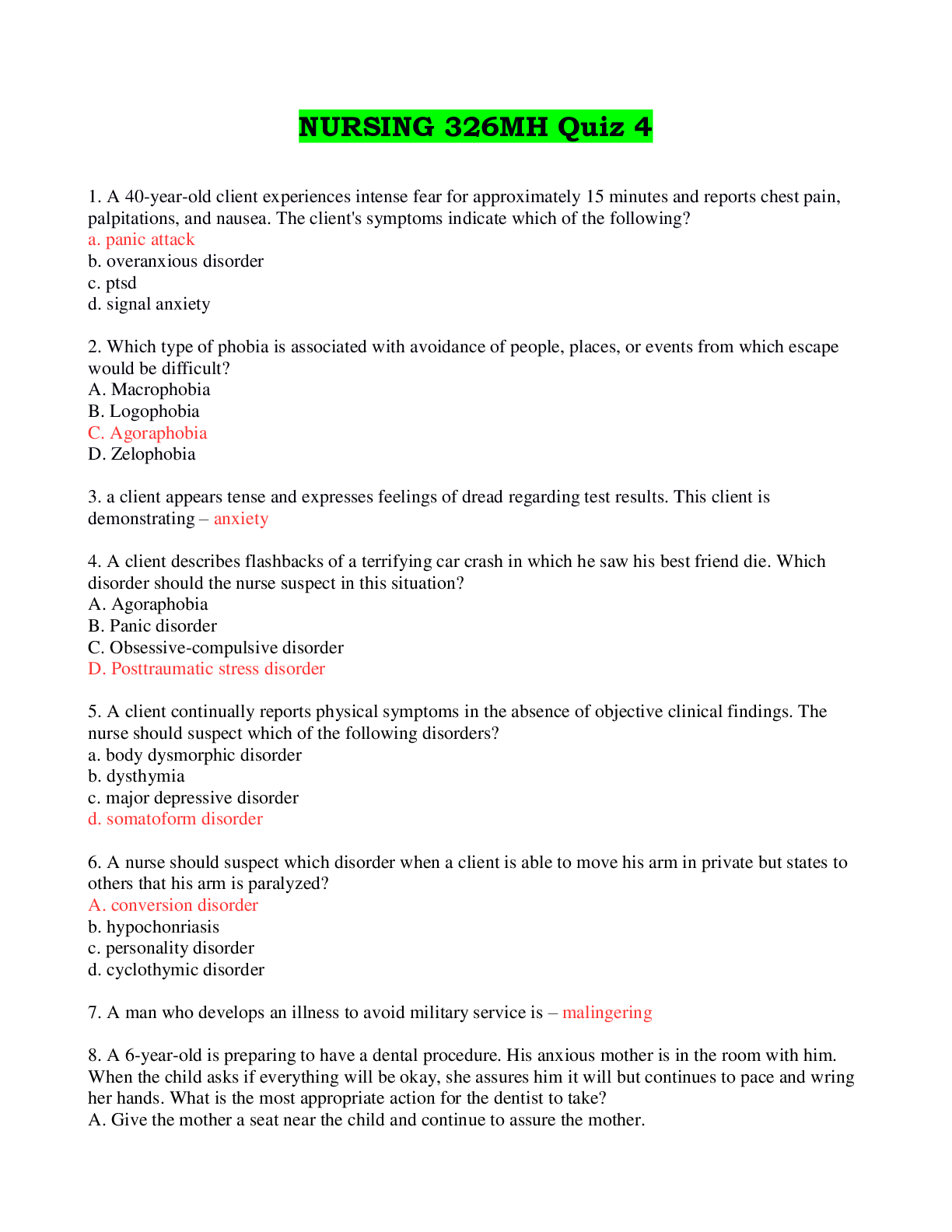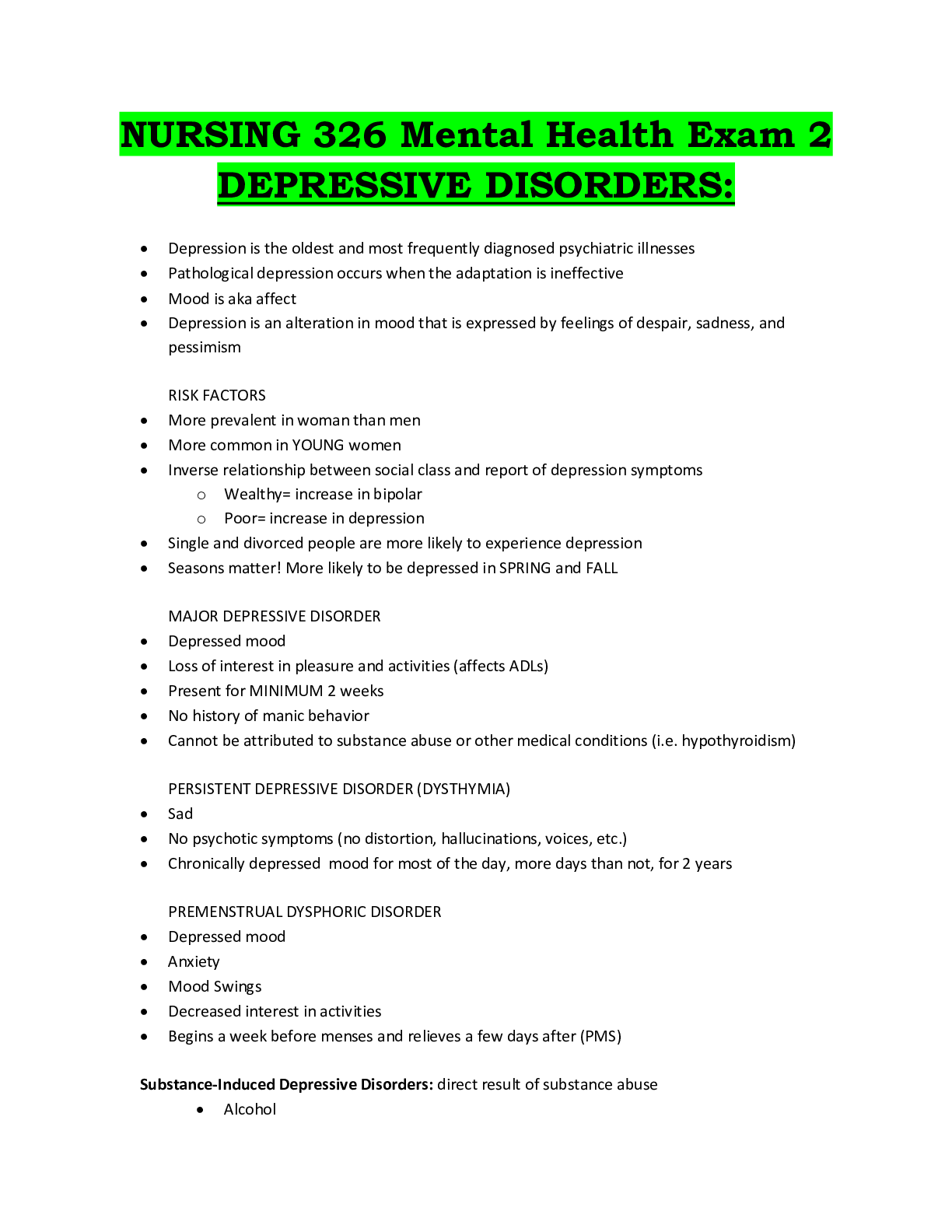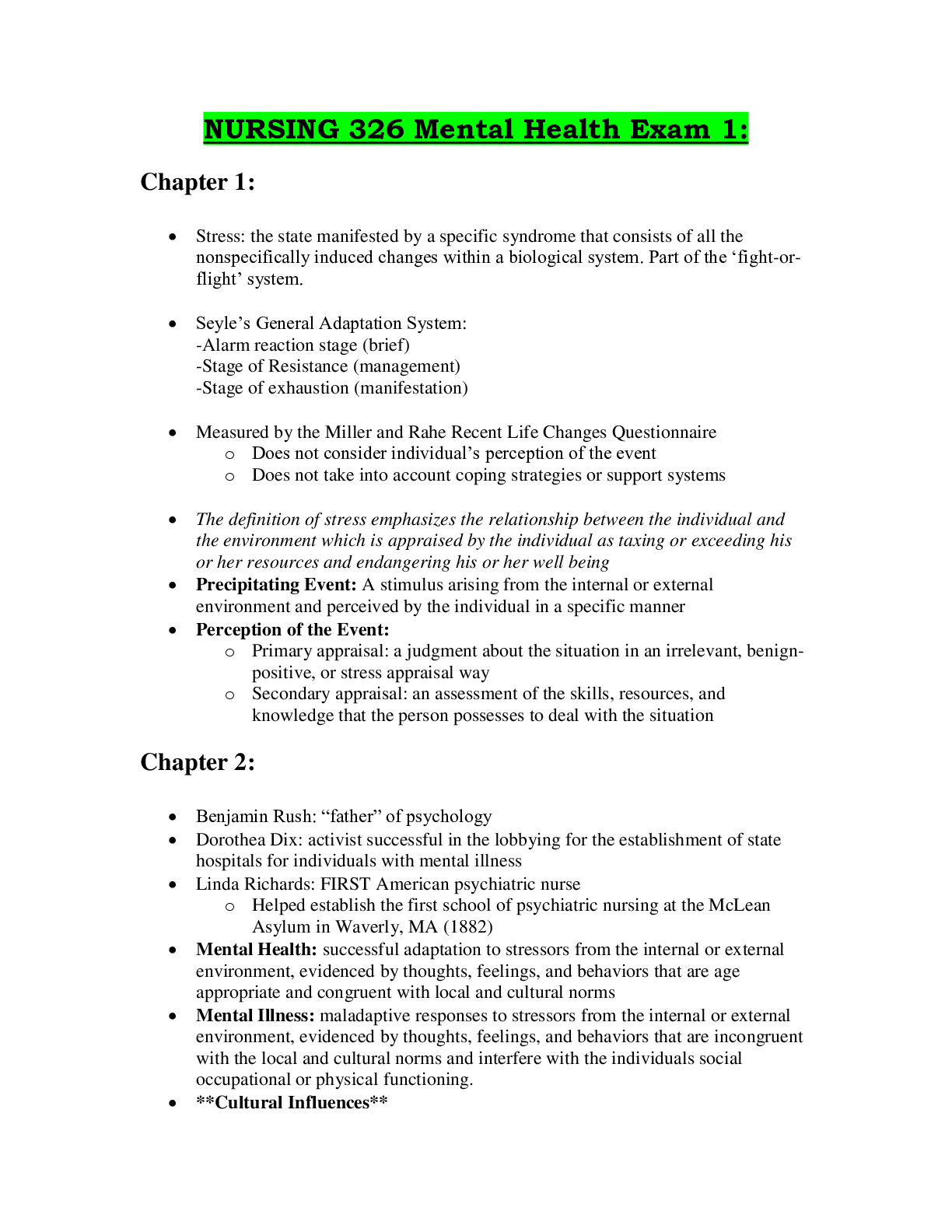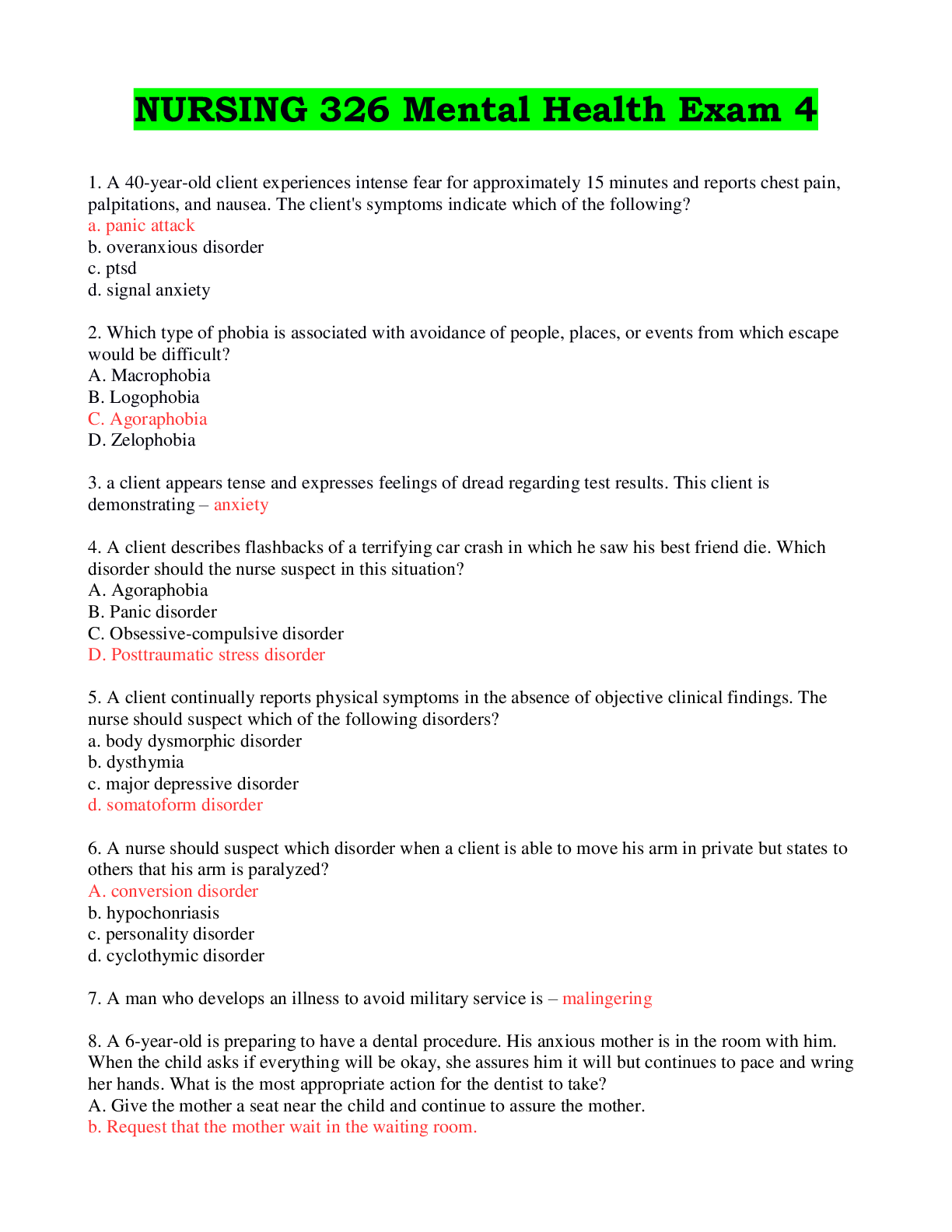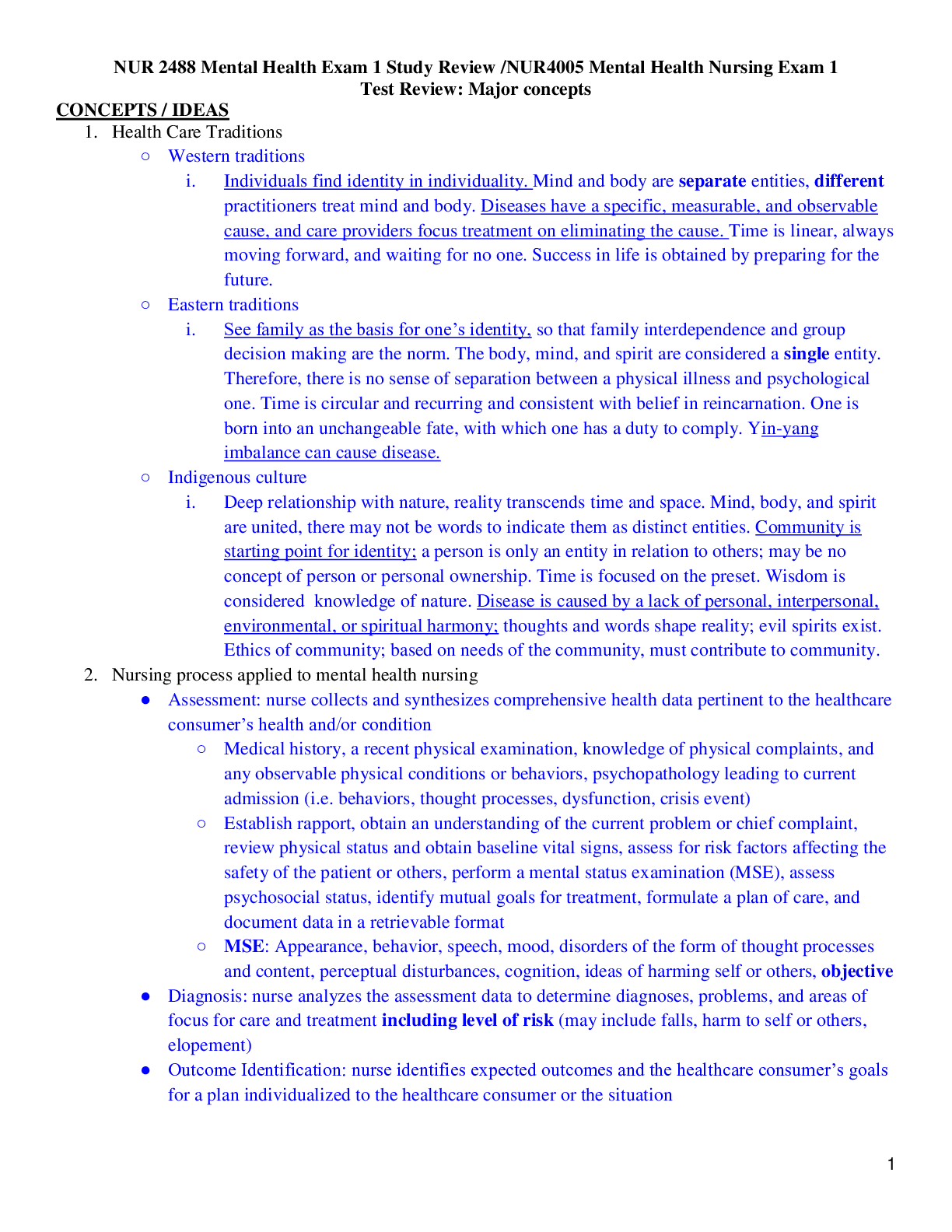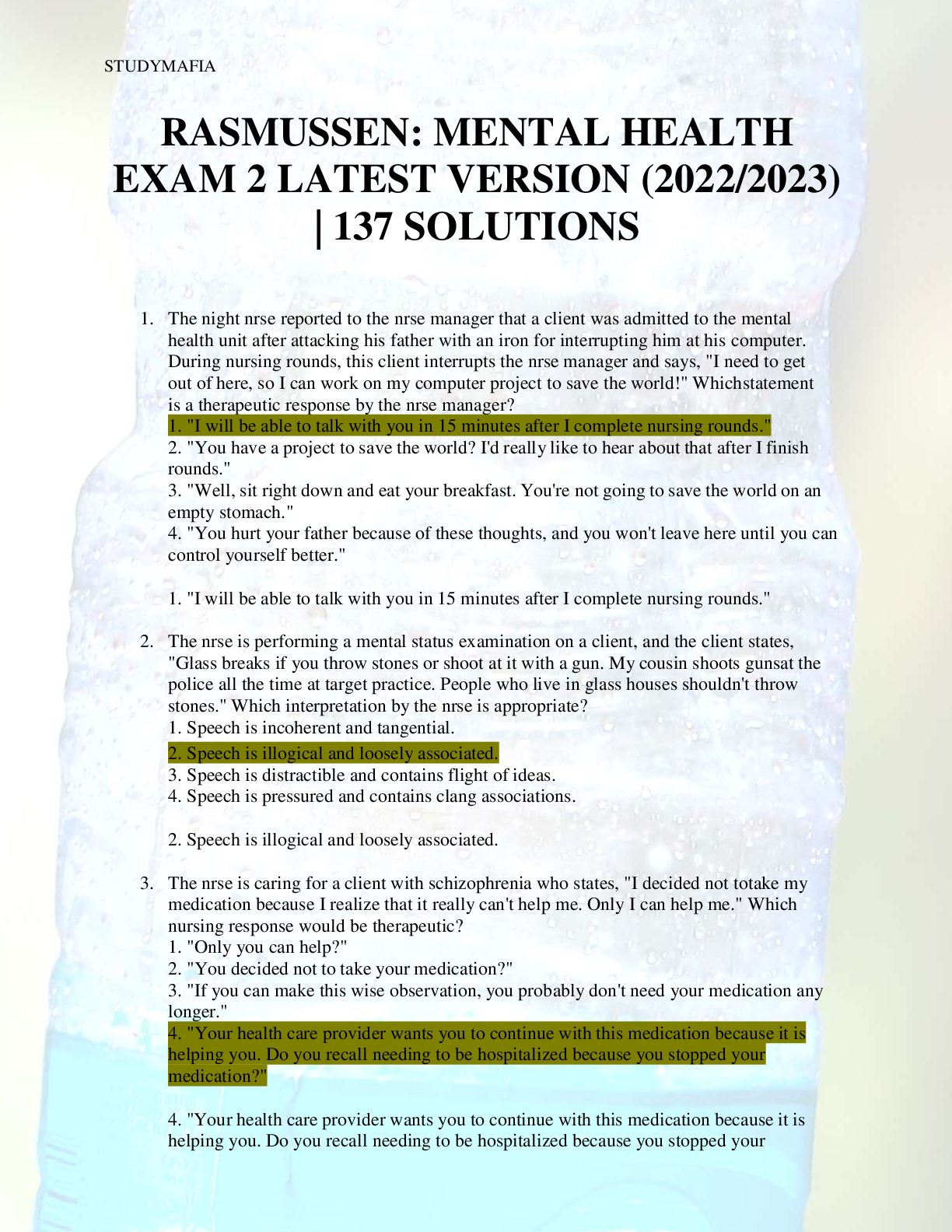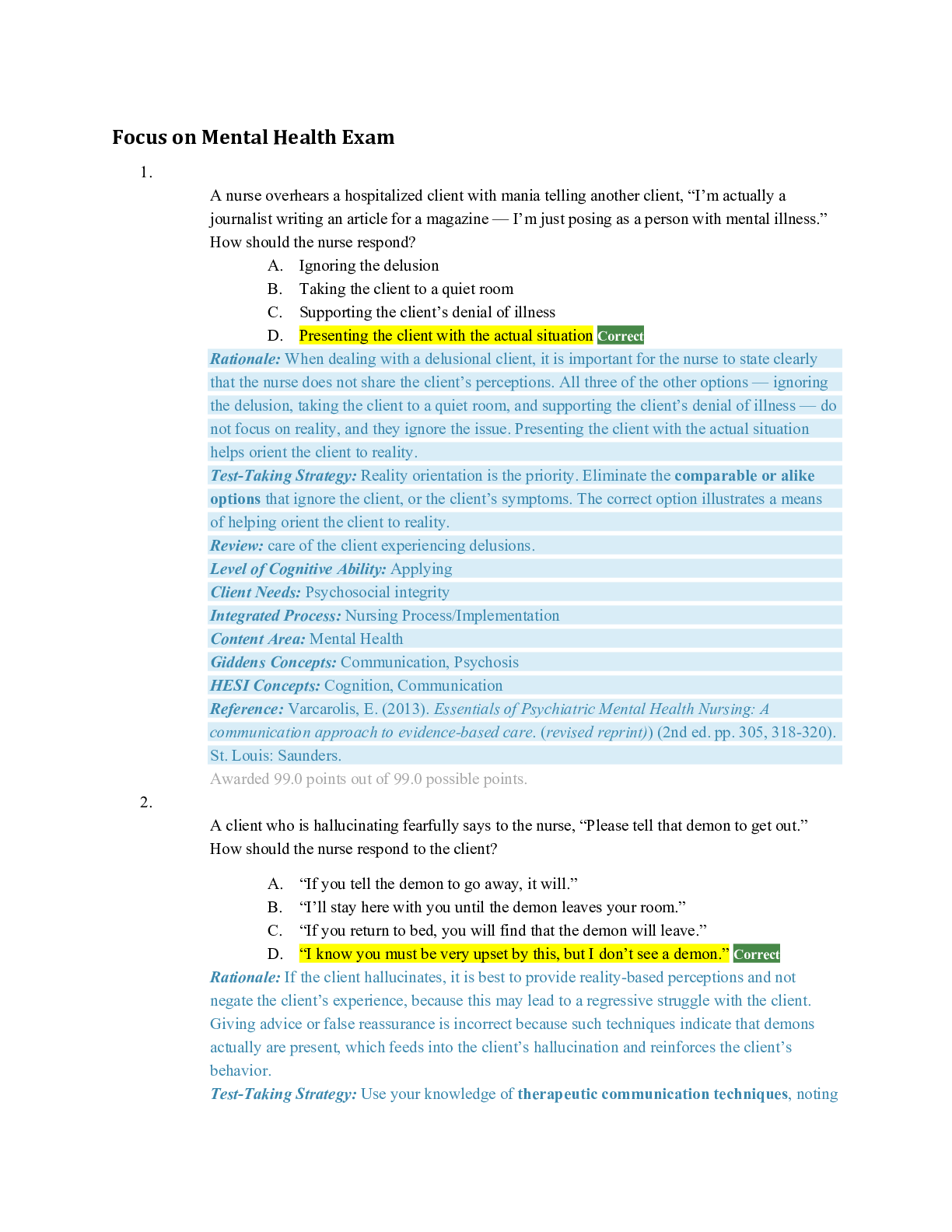*NURSING > EXAM REVIEW > NURSING 326 MENTAL HEALTH EXAM 5 MCQs with answers 100% for GRADE A (All)
NURSING 326 MENTAL HEALTH EXAM 5 MCQs with answers 100% for GRADE A
Document Content and Description Below
NURSING 326 MENTAL HEALTH EXAM 5 Which nursing diagnosis would be most appropriate for an adolescent client suffering from test anxiety who was continually told by her mother that she was inferior... to her siblings and could never amount to anything? A. Noncompliance B. Denial, ineffective C. Violence, risk for other-directed D. Self-esteem disturbance, situational low/chronic low Emotional abuse involves rejection, criticism, terrorizing, and isolation. The result is low self-esteem, in which the adolescent doubts her abilities. The adolescent in this case is not in denial and is not demonstrating behaviors that would alert the nurse to a violent nature. Noncompliance is not an issue in this case. 1. A man who hit his wife yesterday, causing her to fall and break her arm, has called out of work today to take care of her and buy her flowers. He repeatedly tells her how horrible he feels and promises this will never happen again. What stage of the assault is he demonstrating? A. Trigger stage B. Recovery stage C. Escalation stage D. Depression stage The depression stage involves a period of guilt and attempts to reconcile (make up) with others. Aggressors are aware of the assault and genuinely feel bad about it. They may apologize frequently or provide loving care for the victim. The trigger stage occurs prior to the assault, when the stress-producing event occurs. The escalation stage is when actions move closer to a loss of control, and the recovery stage occurs after the violence and injuries are assessed. 2. A person yells, curses, and strikes a bank teller for making her wait in line too long. This behavior is consistent with which of the following? A. Oppositional defiant disorder B. Adjustment disorder C. Conduct disorder D. Intermittent explosive disorder The main feature of intermittent explosive disorder is failure to resist aggressive impulses that result in the destruction of property or assault of another individual. REF: Page 289 3. A 15-year-old female is seen in the clinic for episodes of cutting herself since her parents divorced six months ago. Which nursing diagnosis is a priority for this client? A. Behavior, risk-prone health B. Social interaction, impaired C. Family processes, interrupted D. Spiritual distress The client is demonstrating anger turned inward demonstrated by self-mutilation. The priority would be to prevent the client from further harming herself. Dealing with spiritual distress, impaired social interaction, and interrupted family processes is accomplished after this. 4. The use of inappropriate, harmful, or destructive behaviors to express current or past emotions is defined as: A. Anger B. Acting out C. Aggression D. Assault Acting out is the use of inappropriate, detrimental, or destructive behaviors to express current or past emotions. Anger is a normal emotional response in certain situations; assault is a threat for bodily injury; and aggression is a forceful attitude or action. 5. Which signs and/or symptoms should alert the caregiver to a child who is suffering from neglect? A. Child has torn, stained, or bloody underclothing B. Consistently dirty, hungry, and inappropriately dressed C. Bruises and welts at various stages of healing D. Any fracture in a child younger than 2 years of age or fractures at various stages of healing in a child of any age These are only a few of the signs of neglect. Bruises and fractures are consistent with physical abuse, and torn, stained, or bloody underclothing is seen with sexual abuse. 6. Toddlers often express their anger through: A. Crying B. Temper tantrums C. Manipulation D. Direct aggression Toddlers engage in temper tantrums when they learn to focus their aggression on what they believe is responsible for their anger. 7. Interventions that help caregivers the most in coping with their own anger focus on: A. Assessing which stressors and coping skills are being used B. Learning to effectively control feelings of anger C. Establishing a trusting therapeutic relationship via clear communications D. Learning to effectively interact with clients Although all these interventions are necessary when one is dealing with clients, this intervention allows caregivers to be most effective in caring for individuals who express emotions of anger. 8. A married couple is seeking counseling for domestic abuse issues. The husband states that he can’t control his anger when his wife constantly nags at him. In the assault cycle, the wife’s behavior in this situation is the stage known as: A. Crisis B. Escalation C. Recovery D. Trigger The nagging is the trigger to the assault in this situation. The trigger stage should not be confused as being a justified reason for an assault to occur. 9. As long as the client is limiting her behaviors to verbal assaults and harmless physical movements, A. She is placed in seclusion. B. The caregiver is prepared to apply restraints. C. The acting out may continue. D. She is reminded of the inappropriateness of her behavior. Allow clients to act out as long as they limit their behaviors to verbal assaults and harmless physical movements. However, it is important for the caregiver to maintain control of the situation and set limits on the client’s behavior. 10. A young female has recurrent intrusive thoughts about the act of sexual violence against her. The nurse should suspect which of the following? A. Domestic violence B. Major depressive disorder C. Posttraumatic stress disorder (PTSD) People with PTSD persistently relive traumatic events through sudden, intrusive thoughts called flashbacks. REF: Page 304 D. Emotional abuse 11. Which mental health problems are categorized as anger control disorders? (Select all that apply.) A. Dissociative disorder B. Dysthymic disorder C. Impulse-control disorder D. Adjustment disorder E. Conversion disorder F. Oppositional defiant disorder G. Conduct disorder Conduct disorder, impulse-control disorder, adjustment disorder, and oppositional defiant disorder are all examples of anger control disorders. 12. Abuse during pregnancy endangers the health and well-being of the pregnant woman and her fetus. Which complicating factor is seen twice as much in women experiencing abuse during pregnancy? A. Delivery by caesarean section B. Maternal substance abuse C. Postpartum hemorrhage D. Preterm delivery The number of women who are abused during pregnancy experiencing preterm delivery and low birthweight infants has doubled. Women also postpone prenatal care until the third trimester when it is too late to provide adequate care to treat problems. Hemorrhage after delivery, substance abuse, and operative delivery are not noted as issues more prevalent in abused pregnant women. 13. The nurse should most suspect which of the following when presented with an older, mentally impaired woman who is depressed and underweight and has poor personal hygiene? A. Neglect Neglect can take the form of not providing food, health care, and other basic resources, as well as deliberately causing emotional distress. REF: Page 302 B. Emotional abuse C. Physical abuse D. Exploitation 14. By law, what are health care providers required to do when they encounter incidents of suspected or actual abuse or neglect? A. Investigate B. Report to the client’s family C. Inspect D. Report to the authorities By law, health care providers are required to report violent incidents to the police. It is not mandatory for health care providers to inspect clients if they have not given permission. Investigation is the responsibility of law enforcement officials. Reporting to the client’s family is a breach of confidentiality unless requested by the client. 15. The most therapeutic caregiver intervention for a client with anger and aggression is which of the following? A. Share findings with other caregivers. B. Set limits on client behaviors. C. Establish and maintain a trusting relationship. The goal of the best intervention for aggression is to establish and maintain a trusting therapeutic relationship with honest communication. REF: Page 290 D. Offer prn medication. 16. A 25-year-old woman expresses concern regarding some of her new boyfriend’s behaviors. Which of the following statements might indicate that he has an abusive personality? (Select all that apply.) A. Even though they have been dating for less than 2 months, he wants to get married as soon as possible. B. He finds fault with her family and seeks to convince her that they are trying to sabotage her relationship with him. C. He does not allow her to go out with friends unless he accompanies them. D. He has a poor relationship with his own parents, blaming them for not supporting him after he was fired from various jobs. E. He would like to further his education but realizes that he must first work for a while to pay off student loans. Early signs of an abusive personality include a push for quick involvement, as seen in the rush to get married. Demonstrating jealous and controlling behaviors in not allowing his partner to go out with friends, blaming his family for his own problems, and attempting to isolate his partner from her family are also signs of an abusive personality. Working to pay off loans before furthering education is a realistic expectation and not indicative of an abusive personality. 17. The term used for the unlawful use of force on a person without his or her consent is which of the following? A. Acting out B. Assault C. Violence D. Battery Battery, a term related to anger, is the unlawful use of force against an individual. REF: Page 285 18. Persons who naturally relate aggressively to others, seldom have empathy, and lack appropriate guilt feelings are given the diagnosis of ____ disorder. A. Adjustment B. Oppositional defiant C. Impulse-control D. Conduct These are characteristics of conduct disorders. Adjustment disorders are characterized by a psychological response from an identifiable stressor or group of stressors that causes significant emotional or behavioral symptoms that do not meet criteria for more specific disorders; impulse-control disorders are characterized by a failure to resist impulses or temptations that are harmful to the person or to others; and oppositional defiant disorder refers to a pattern of negative, aggressive behaviors that is seen most commonly in children who focus on authority figures. 19. Many victims of violence believe that their abusers may attempt to hurt them again, even as they are seeking help. Recognizing this, the care provider: A. Does not leave the client alone B. Immediately gets the name and phone number of the perpetrator C. Posts security guards at the door D. Leaves the client alone no longer than 15 minutes The first priority of care for every victim of violence is to ensure safety and security. 20. A nurse recognizes unexplained fussiness and irritability in an infant as well as unexplained injuries. The nurse should suspect which of the following? A. Sexual abuse B. Neglect C. Munchausen syndrome by proxy D. Shaken baby syndrome Shaken baby syndrome should be suspected in every infant with unexplained or vague injuries and unexplained lethargy, fussiness, and irritability. REF: Page 300 21. __________ is a forceful attitude or action that does not take into consideration others’ feelings or needs and may be expressed verbally, physically, or symbolically. Aggression Aggressive behaviors usually are a result of anger. 23. A male client is being seen for anger management issues following an incident in which he was late for work, became angry at the driver in front of him for not driving faster, and intentionally ran into the car at a stop sign. This client is displaying actions most typical of: A. Passive aggressive behavior B. Oppositional defiant disorder C. Intermittent explosive disorder D. Adjustment disorder with anxiety The main characteristic of intermittent explosive disorder is the failure to resist aggressive impulses that result in assault of another individual or property. Passive aggressive behavior, oppositional defiant disorder, and adjustment disorder with anxiety do not result in injury or harm to persons or property. 24.Which of the following is a bullying behavior? A. Encouraging others to stay away from the disliked person Exclusion from activities and others is a bullying behavior. REF: Page 301 B. Taking property from the disliked person C. Disliking the way the person dresses D. Avoiding a disliked person 25. Whenever there is a history of unexplained lethargy, fussiness, or irritability in an infant, caregivers should suspect ____ syndrome. A. Drugged baby B. Shaken baby C. Feeding disorder D. Depressed infant Shaken baby syndrome should be suspected when an infant has unexplained or vague injuries. This form of child abuse results when the child is vigorously shaken, leading to whiplash-induced bleeding in the brain. 26.During the first phase of the domestic abuse cycle, the female victim of domestic violence inflicted by a male usually displays which characteristics or behaviors? (Select all that apply.) A. Feeling that she deserves minor abuse B. Denial of the seriousness of the problem C. Blaming alcohol and work for the man’s behavior D. Feeling that she cannot control the man’s behavior The first cycle is the tension phase. During this phase, the woman feels that she can control the man’s behavior, and she feels that she does not deserve minor abuse. 27. A husband is yelling and swearing at his wife during an argument. He also is pacing and pounding his fist. This pattern of behavior is consistent with which stage in the assault cycle? A. Trigger stage B. Recovery stage C. Crisis stage D. Escalation stage The escalation phase is the building stage during which each behavioral response moves closer to total loss of control. REF: Page 288 28. Which theory states that males are socialized throughout childhood to behave more aggressively and violently? A. Sociological theory B. Feminist theory Feminist theories use the concept of machismo, defined as compulsive masculinity, to explain the occurrence of violence against women. REF: Page 296 C. Anthropological theory D. Social learning theory 29. An out-of-control client is verbally abusive and physically aggressive with staff members who are at increased risk for injury. Which intervention is most appropriate? A. Take a time-out. B. Apply restraints. Restraints may be necessary as an intervention for the control of assaultive behaviors. REF: Page 292 C. Administer oral medication. D. Call a family member or friend. 30. Which of the following is a common characteristic of an abuser? A. Blames self for own problems B. Secure with self C. History of substance abuse D. Control of emotions 31. When a functional family is faced with a crisis or unexpected situation, which of the following behaviors do they exhibit to overcome it? A. Avoid the conflict and focus on positive aspects of their lives B. Isolate the family and attempt to reach resolution without outside interference C. Maintain clear and supportive communication to address the crisis D. Look to the head of the family to resolve based on role A functional family unit is described by what it does (processes) to achieve its goals. These processes include clear and supportive communications among all family members. Isolating the family does not allow them to use resources outside the family, avoidance of conflict does not promote resolution, and assigning goal planning to one member does not describe the actions of a functional family 32. The term that describes repeated physical abuse, usually of a woman, child, or elder, is: A. Battering B. Exploitation C. Neglect D. Gender abuse This is the definition of battering. Neglect is defined as causing harm to another’s health or welfare through failure to provide for basic needs or by placing the person’s health or welfare at unreasonable risk. Exploitation refers to using an individual for selfish purposes or for profit. Gender abuse is described as various forms of abuse directed toward women. 33. During the recoil stage of recovery from violence, the major characteristic is: A. Fear B. Struggle to adapt C. Reconstruction D. Disorganization The recoil stage is when the individual becomes aware of the impact of the violence on his or her life. Fear and disorganization occur during the impact stage, and reconstruction occurs during the reorganization stage. 34. A rule of thumb for recovering from a rape or other violent experience states that the greater the force or brutality, the greater the psychological harm and: A. Legal implications B. Recovery time C. Financial difficulty D. Social dysfunction Recovery time is directly related to the level of the attack 35. Which of the following persons is exhibiting passive aggression? A. The woman who willingly volunteers to help out at her child’s school play B. The woman who agrees to cover a co-worker’s shift and complains to customers that she is supposed to be home C. The woman who asks a co-worker to cover her shift D. The woman who says no when asked to go to a charity event A person demonstrating passive aggressive actions expresses anger in indirect ways. Instead of declining to cover the shift, the person complains to others. The other examples do not demonstrate this indirect anger. 36.__________ typically express anger and/or aggression with temper tantrums. Toddlers This is typical of the toddler years. Anger and aggression are expressed in some form from infancy until death. 37.__________ refers to a sudden occurrence of physical force that causes harm or injury to another person. Violence Violence is a type of physical activity that is socially unacceptable. 38. Which situation would most negatively affect a female client with a diagnosis of adjustment disorder? A. Marrying her partner she has lived with for 5 years B. Beginning college after graduating from high school 12 years ago C. Meeting with a friend with whom she keeps in contact but has not seen for 8 years D. Being promoted in the company at which she has worked for the past 10 years Individuals with adjustment disorders have the greatest difficulty in adapting to new situations. Therefore, beginning college has the most stress potential because it has no familiar aspect to it, as the other options do. 39. A physically or mentally impaired older woman who is living with a relative and has a history of unexplained bruises or injuries, burns in unusual places, or poor personal hygiene is likely a victim of: A. Child abuse B. Adolescent abuse C. Neglect D. Elder abuse These are typical signs of elder abuse, which most typically occurs among family members. 40. A female who is physically abused by her husband arrives in the emergency department following a serious battering incident. During this phase of the domestic abuse cycle, the nurse expects the client to: A. Believe in the permanency of their relationship and believe that it will not happen again B. Have experienced the battering episode a few days prior to the incident C. Ask the emergency department nurse to call the police immediately to arrest her husband D. Be very nurturing and compliant and seeking to please her husband This is typical of the second phase of the cycle of domestic violence following a serious battering incident. The client may also lie about the cause of the incident. During this second phase of the cycle the victim usually asks for the police not to be involved for fear of future battering in retaliation. The client is usually nurturing and compliant in the first phase of the cycle when tension is building. During the honeymoon phase (or third phase), the client believes in the permanency of the relationship. 41. While an abused woman cannot be categorized to fit a specific profile, which of the following traits is most commonly identified? A. Accomplished in nontraditional female career B. Suspicious nature C. Trusting nature D. Assertive personality There is no “typical” abused woman, but the victims of violence do have some characteristics in common. Perhaps the most common trait is a trusting nature, as opposed to a suspicious nature. Many women were raised to be nonaggressive and traditional, as opposed to assertive and accomplished in nontraditional female careers. 42. A male who, as a child, observed the women in his family being dominated is, in his own life, more likely to: A. Battery B. Love C. Order around D. Belittle The social learning theory considers this to be a contributing factor to a male who has become a batterer. 43. What concept do feminist theories use to explain violence against women? A. Muscularity B. Machismo C. Masculinity D. Femininity Machismo is defined as compulsive masculinity that results in aggressive and violent behavior directed toward women, which occurs as the result of socialization of this behavior throughout childhood. 44. During the psychosocial portion of the assessment of a client with anger, aggression, or violent behavior issues, the nurse will assess which of the following? (Select all that apply.) A. Cultural, spiritual, and occupational interests B. General appearance C. Potential for engaging in inappropriate behavior D. Coping skills E. Value and belief systems Assessing coping skills, whether the client has a value and belief system, and cultural, spiritual, and occupational interests are components of the psychosocial portion of the assessment. Assessing potential for engaging in inappropriate behavior and general appearance occur during the initial portion of the assessment and during the mental status assessment, respectively. 45. Eating disorders, substance abuse, delinquent behaviors, posttraumatic stress disorder, and suicide most commonly are seen as the result of abuse in this population: A. Adults B. Elderly C. Children D. Adolescents These disorders most frequently are seen as the result of abuse of adolescents, and abuse of this age group is the most overlooked type of family violence. 46. An elderly client admits that her daughter regularly abuses her. She is a victim of ________. Battering Battery is a term that describes repeated physical abuse of someone, usually a woman, child, or elder. REF: Page 297 47. Which of the following is a common characteristic of an abused woman? A. Nontraditional B. Nonaggressive Nonaggressive and traditional beliefs parallel the idea that the man is master and protector of the household and the woman should be submissive to the man. REF: Page 298 C. Educated D. Young 48. Which of the following psychosocial nursing diagnoses are related to anger and aggression? (Select all that apply.) A. Coping ineffective, individual B. Anxiety C. Violence, risk for self-directed D. Violence, risk for other-directed E. Hopelessness F. Fear Anxiety, hopelessness, ineffective coping, and fear are all potential nursing diagnoses related to anger and aggression. Violence, risk for other-directed, and violence, risk for self-directed, are diagnoses in the physical realm. 49. __________ refers to abuse or battering of a family member by another family member. Domestic violence Domestic violence can be psychological or physical. 50. A client threatens the nurse and smacks the attending physician. Both are examples of ________. Violence 51. Which are characteristics of a dysfunctional family? (Select all that apply.) A. Clear and supportive communications B. Members are self-centered C. Inconsistent authority D. No clearly defined roles E. Family boundaries are rigid F. Setting goals G. Occasional arguments A dysfunctional family is described by its inability to fulfill its basic functions. All other options represent a well-functioning family dynamic. [Show More]
Last updated: 1 year ago
Preview 1 out of 11 pages

Reviews( 0 )
Document information
Connected school, study & course
About the document
Uploaded On
Mar 18, 2021
Number of pages
11
Written in
Additional information
This document has been written for:
Uploaded
Mar 18, 2021
Downloads
0
Views
36



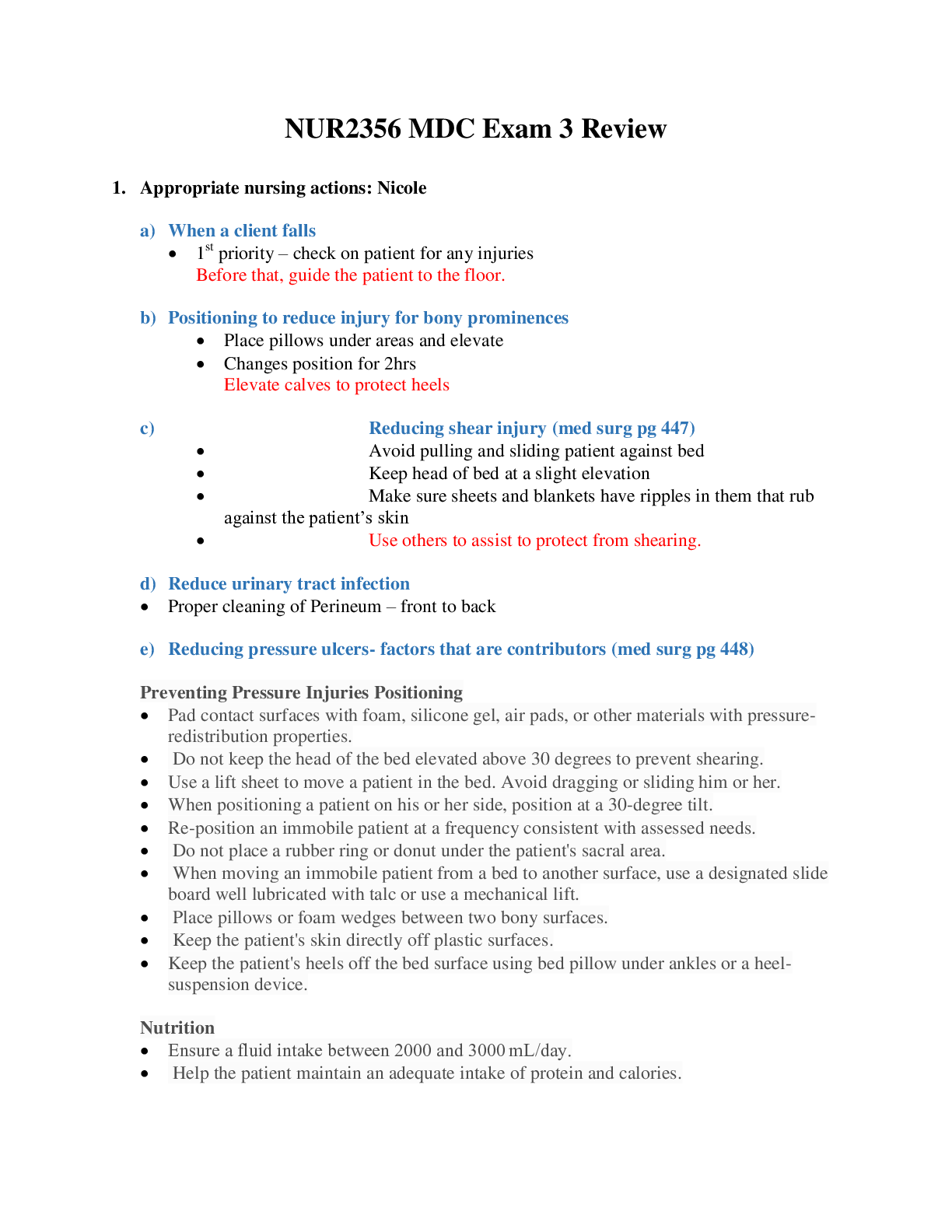
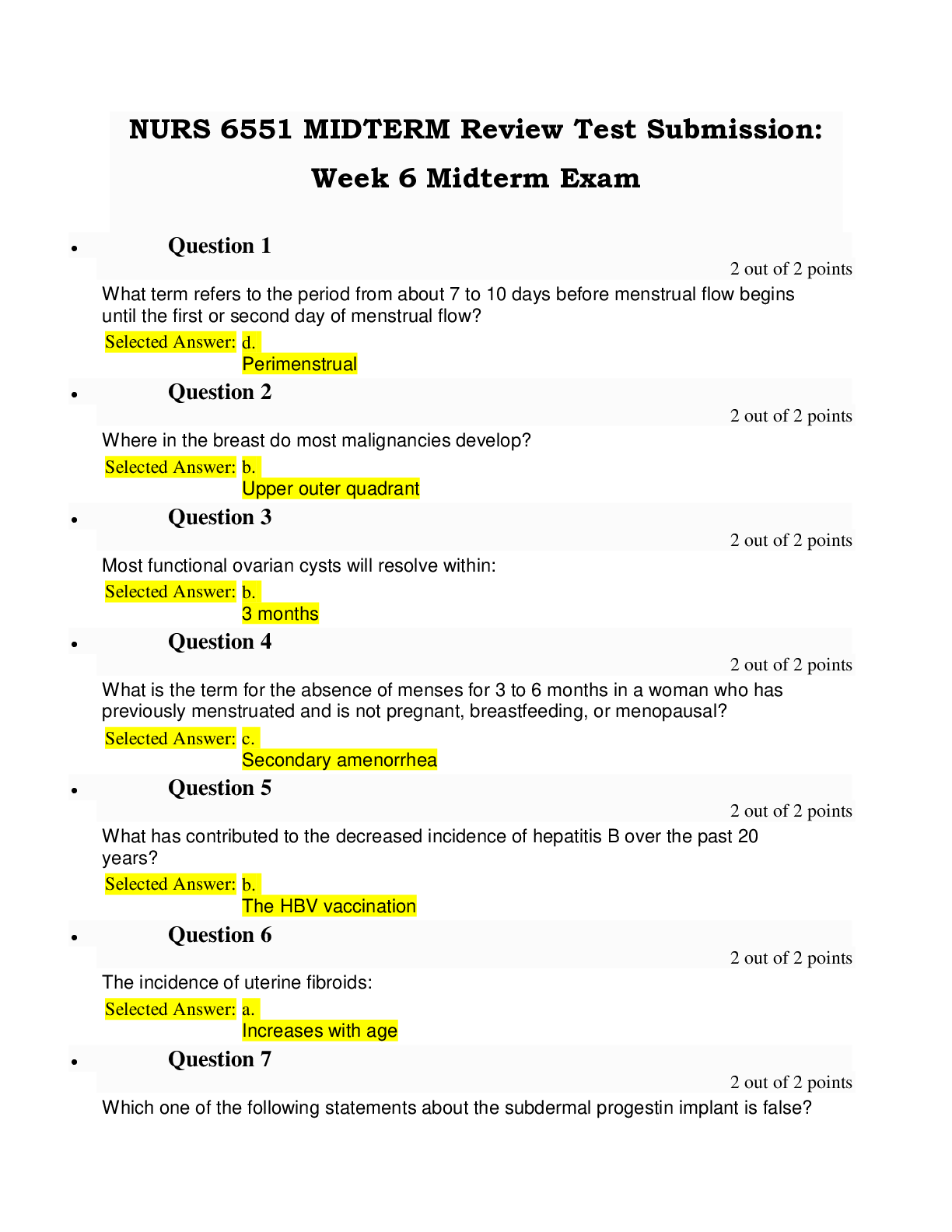





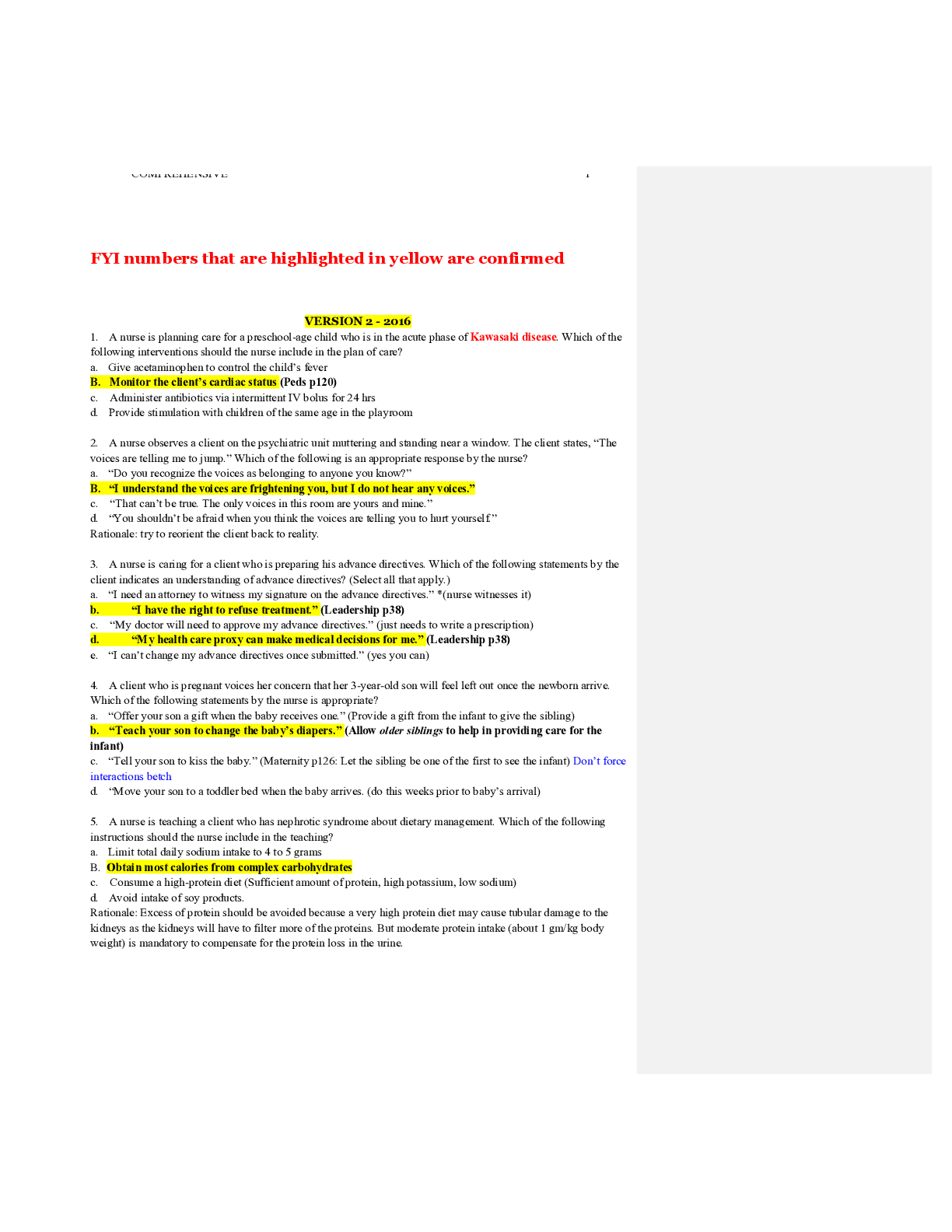
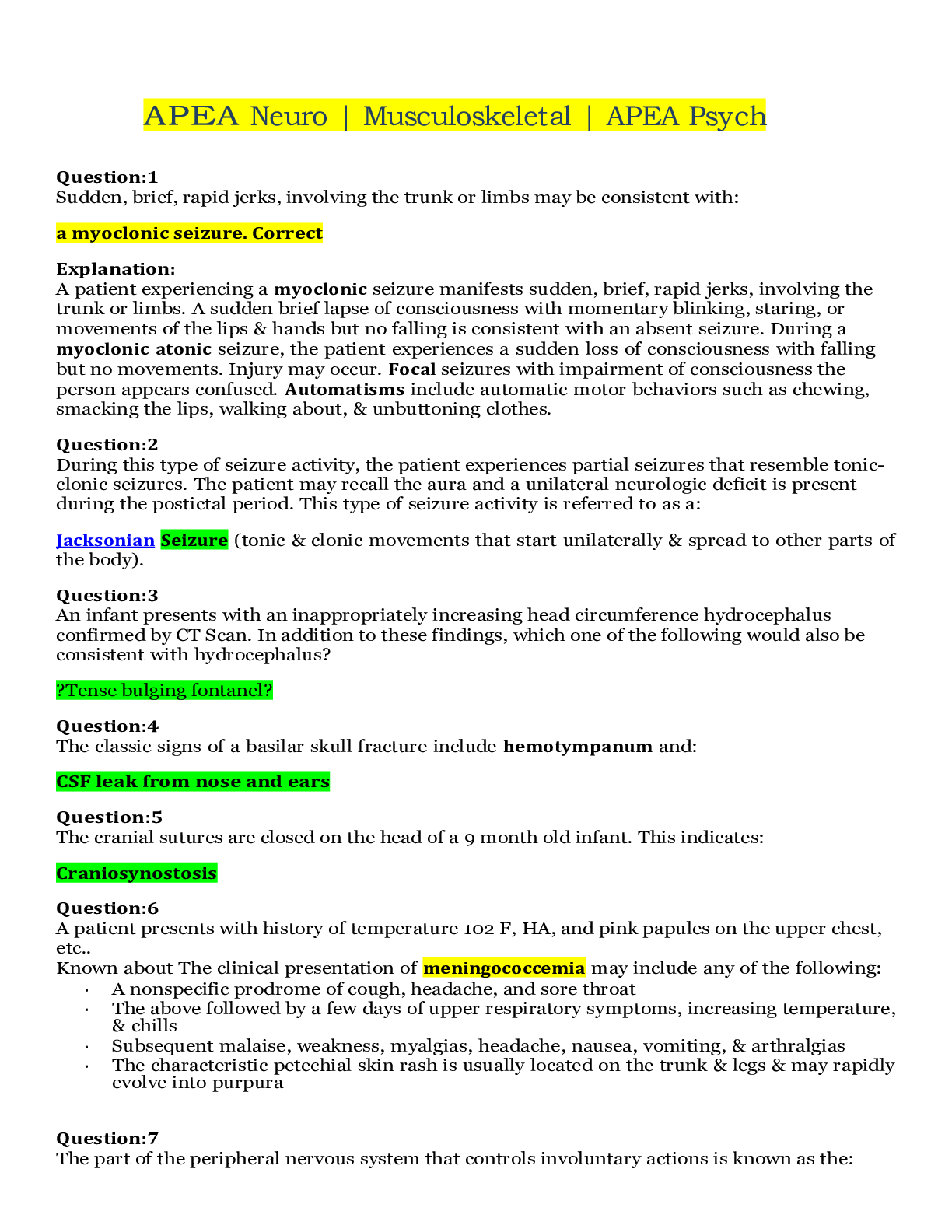
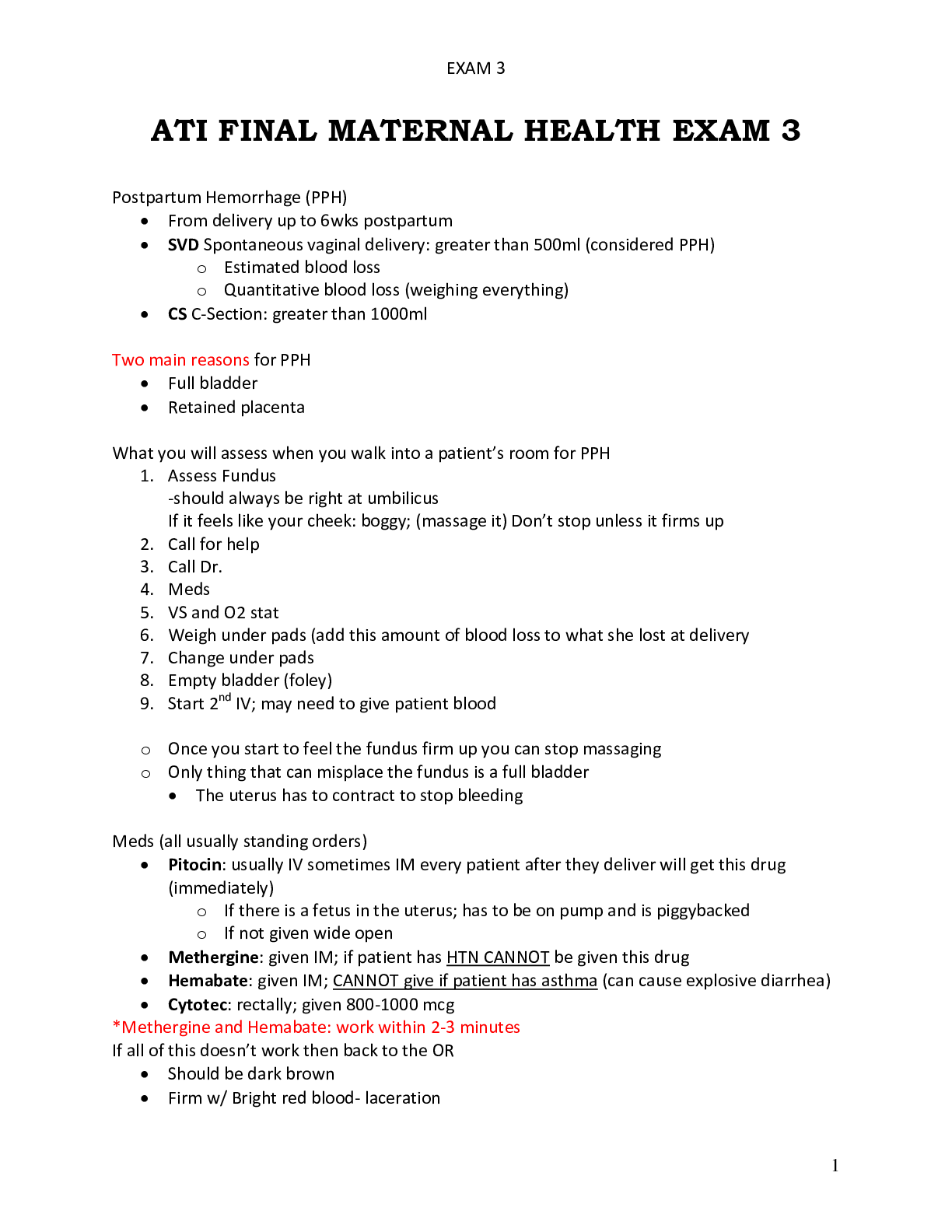
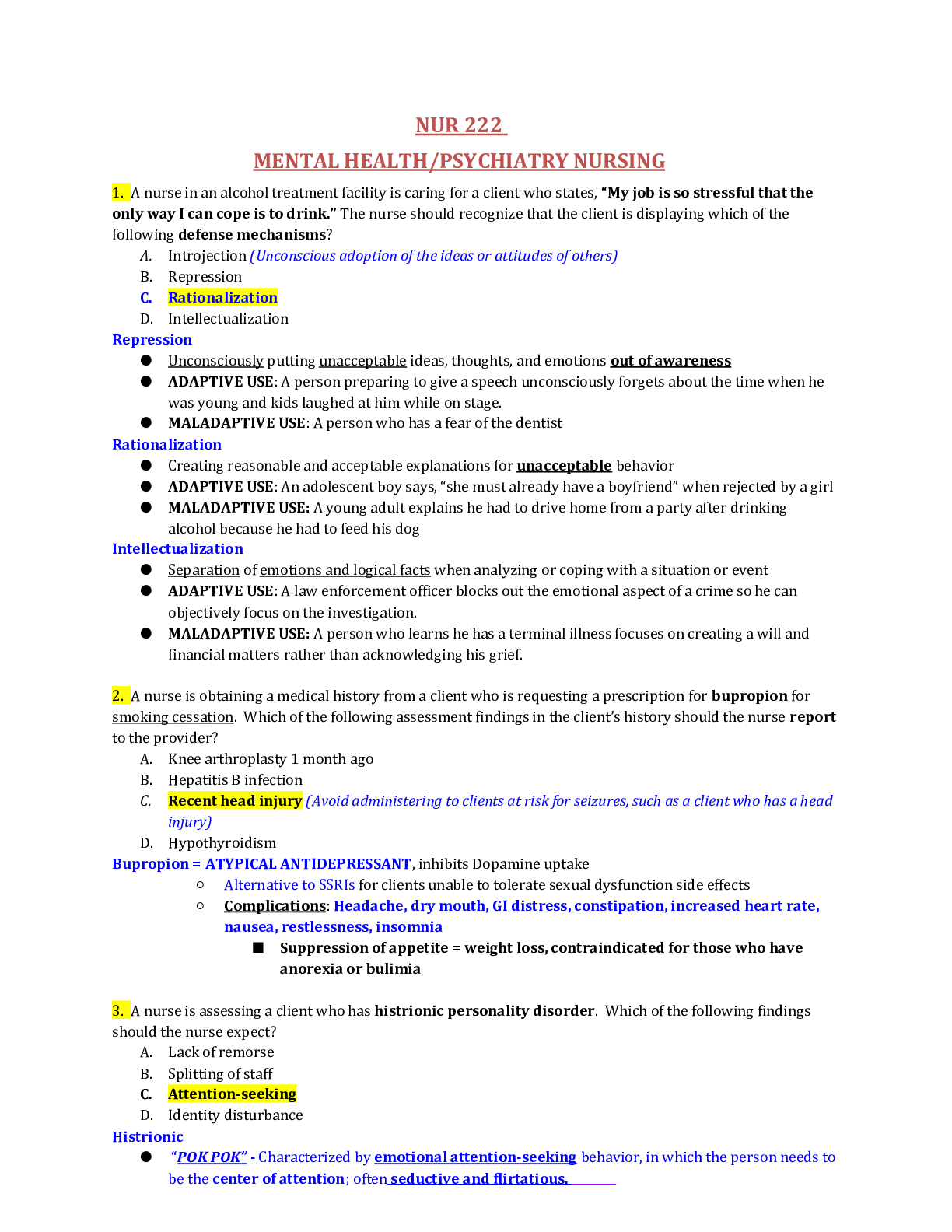

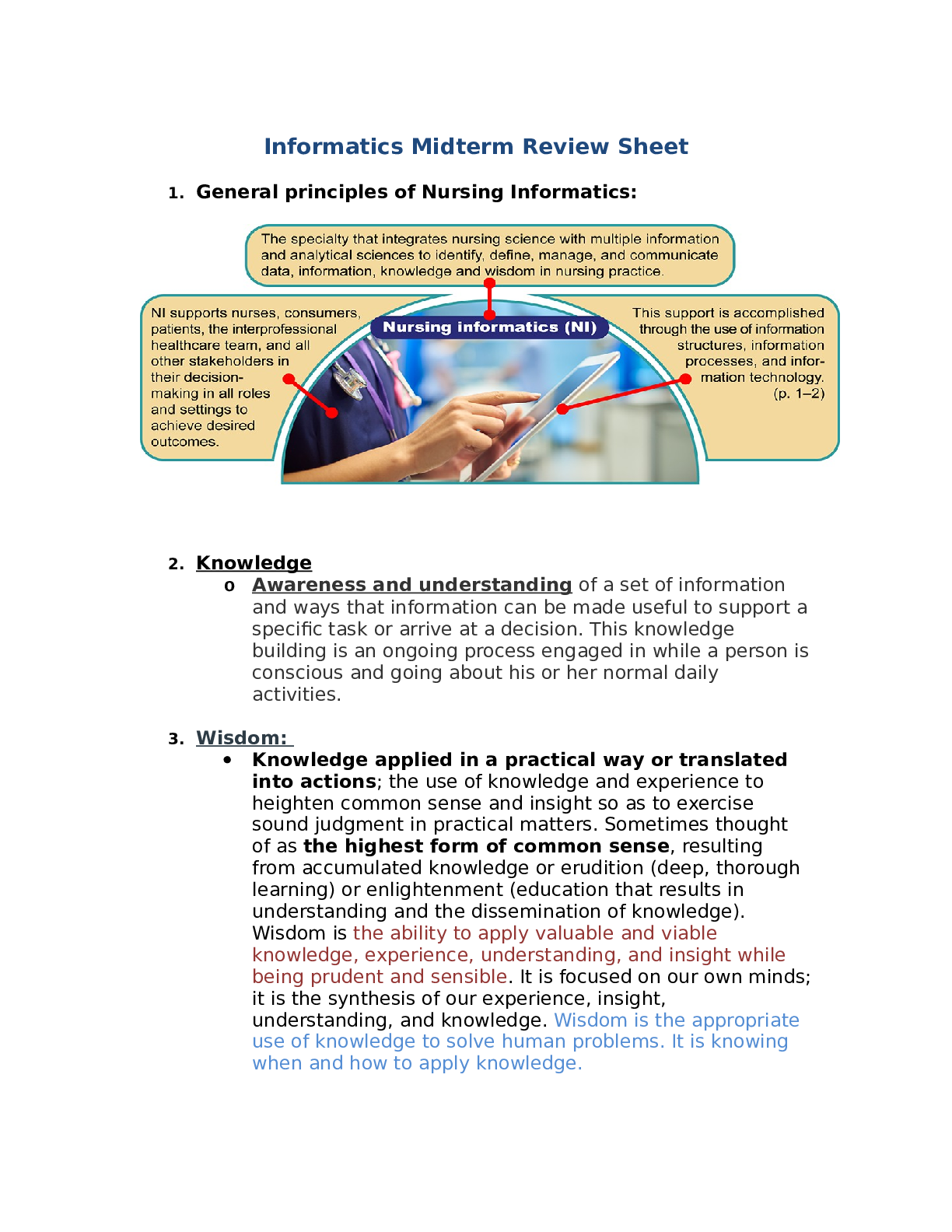
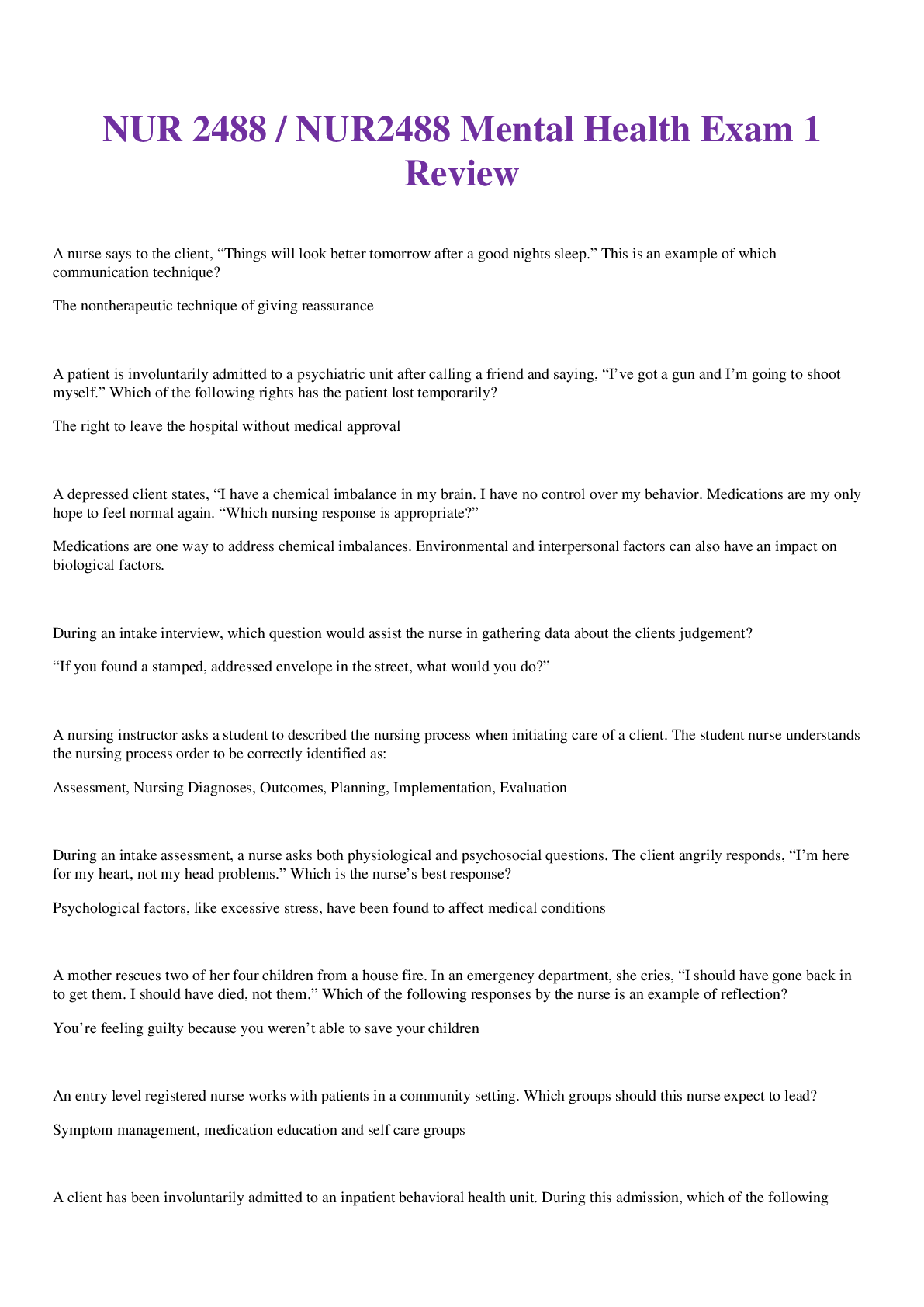
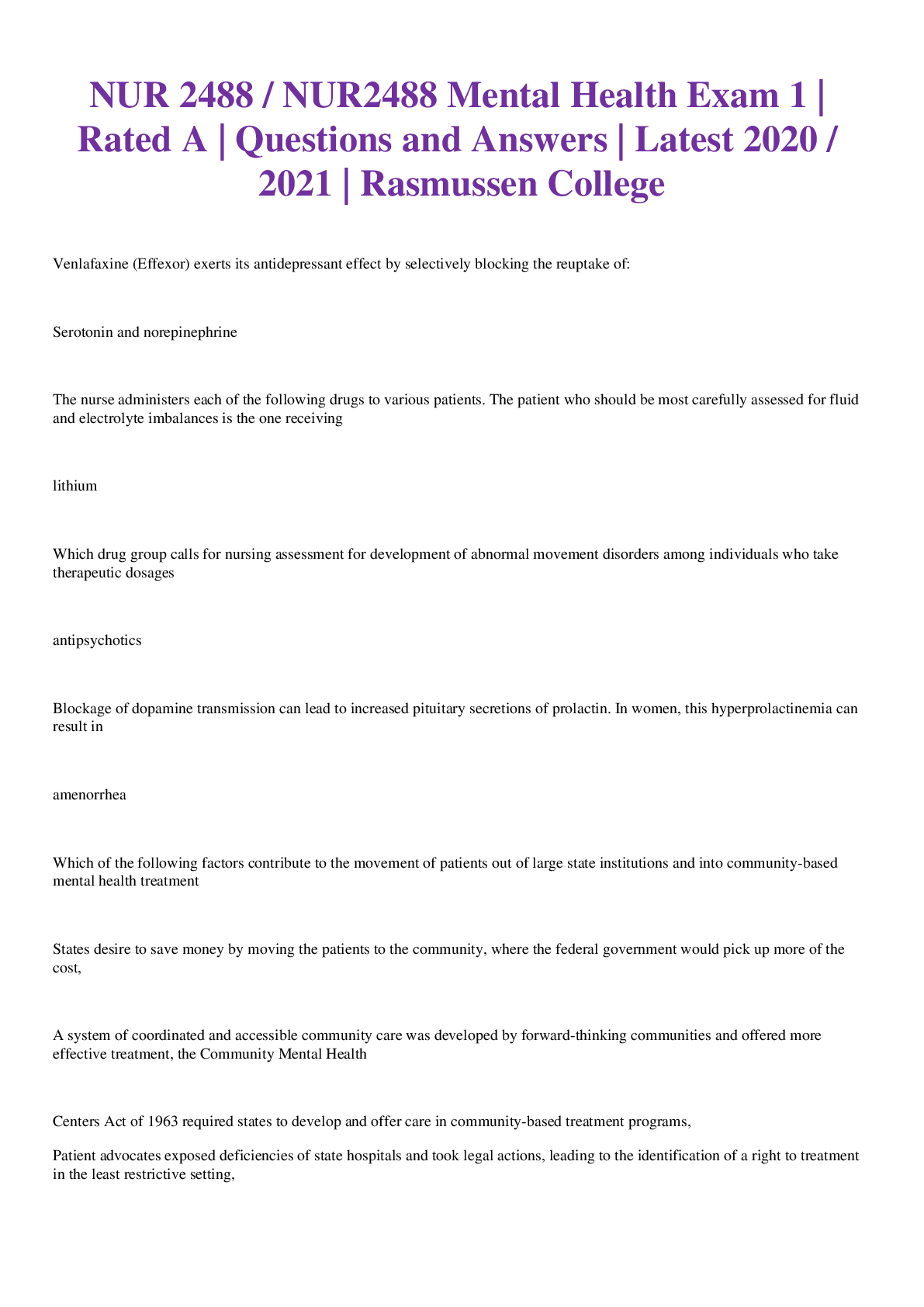
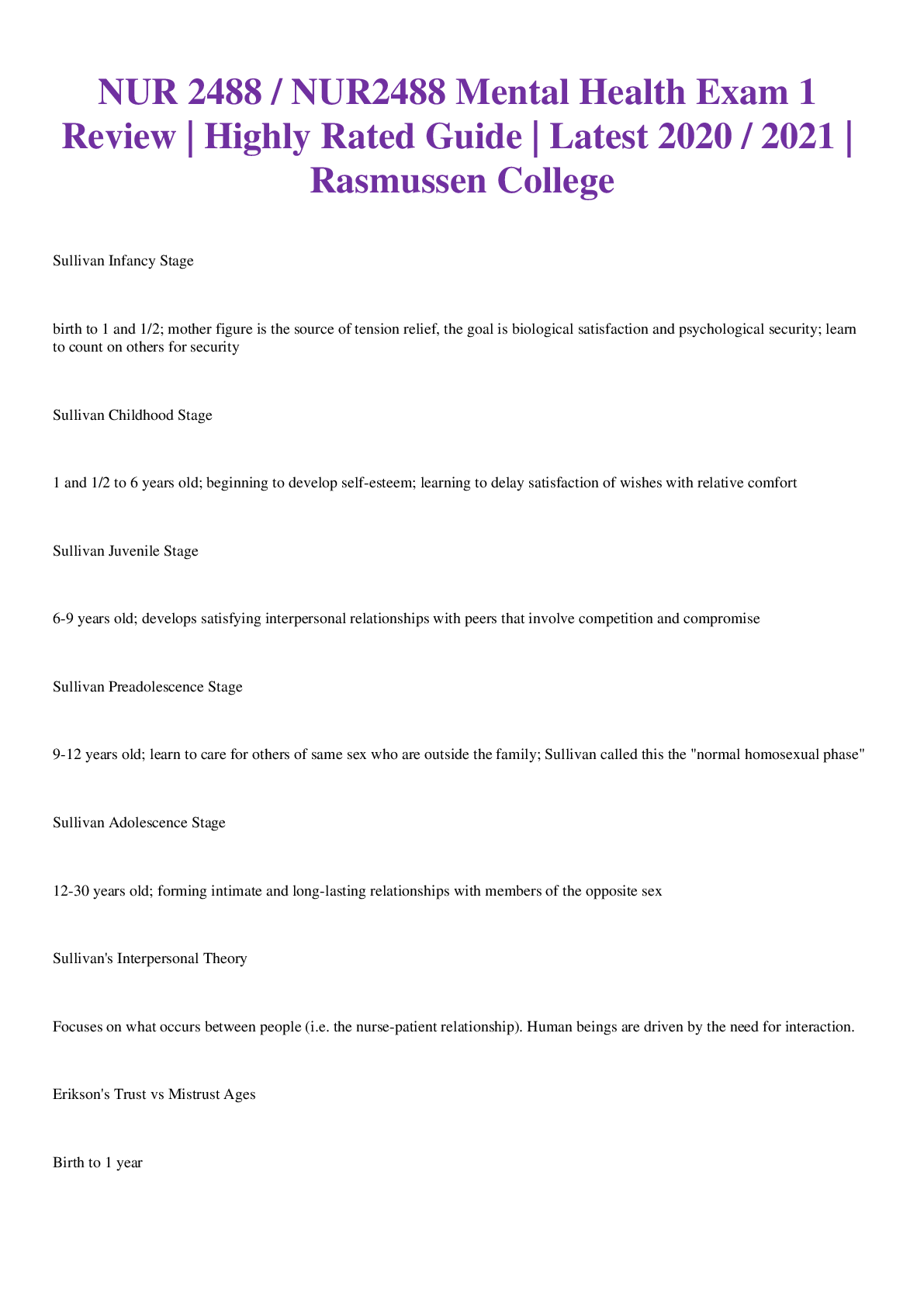

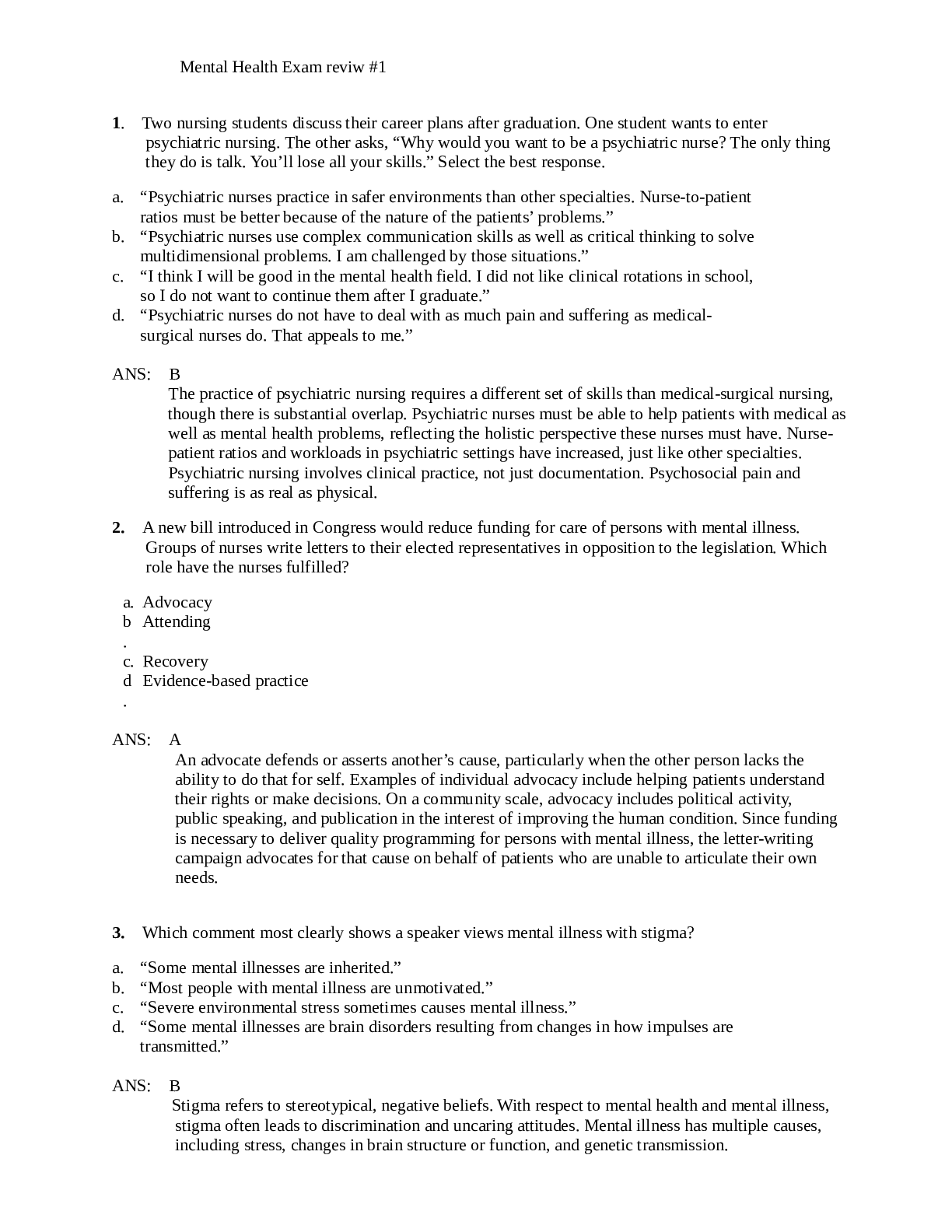
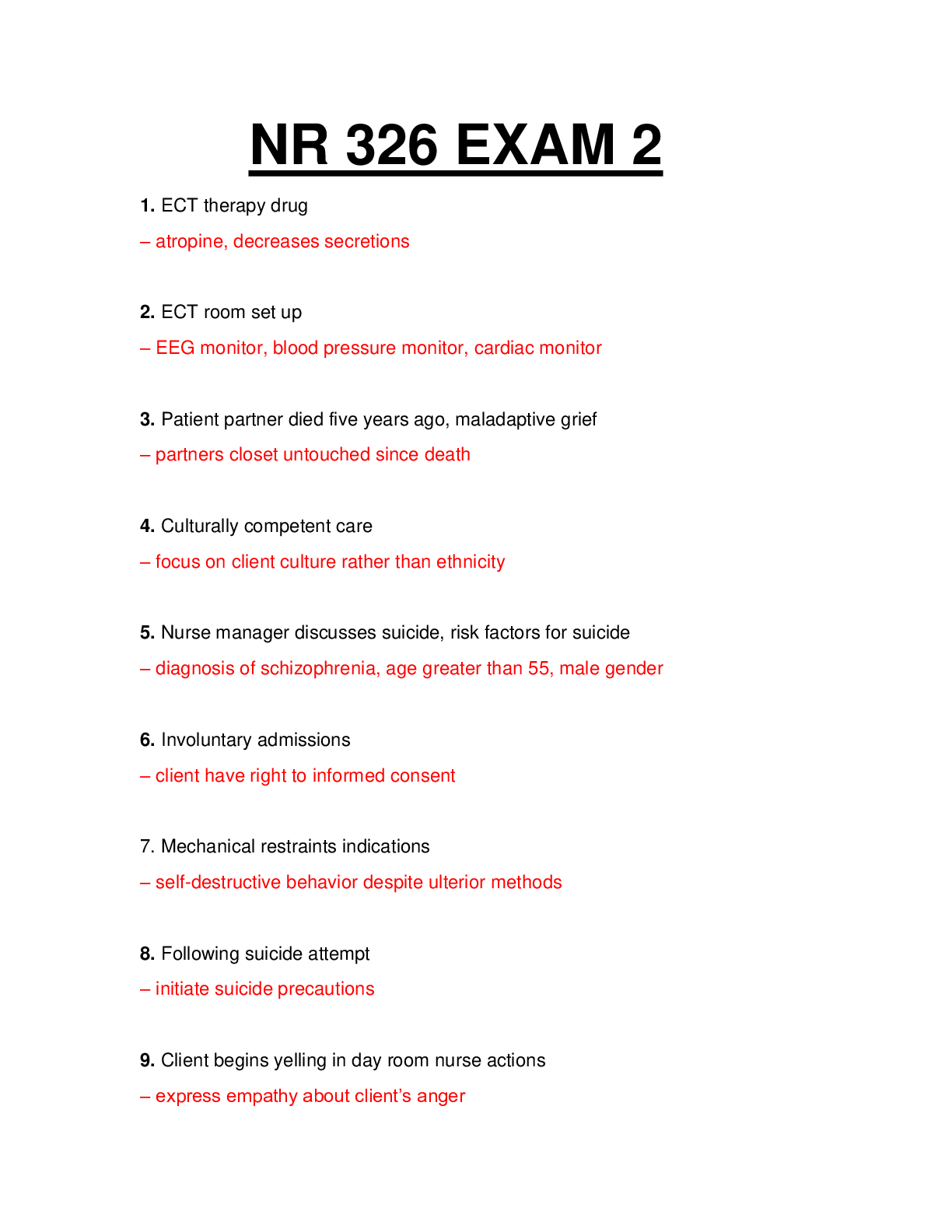
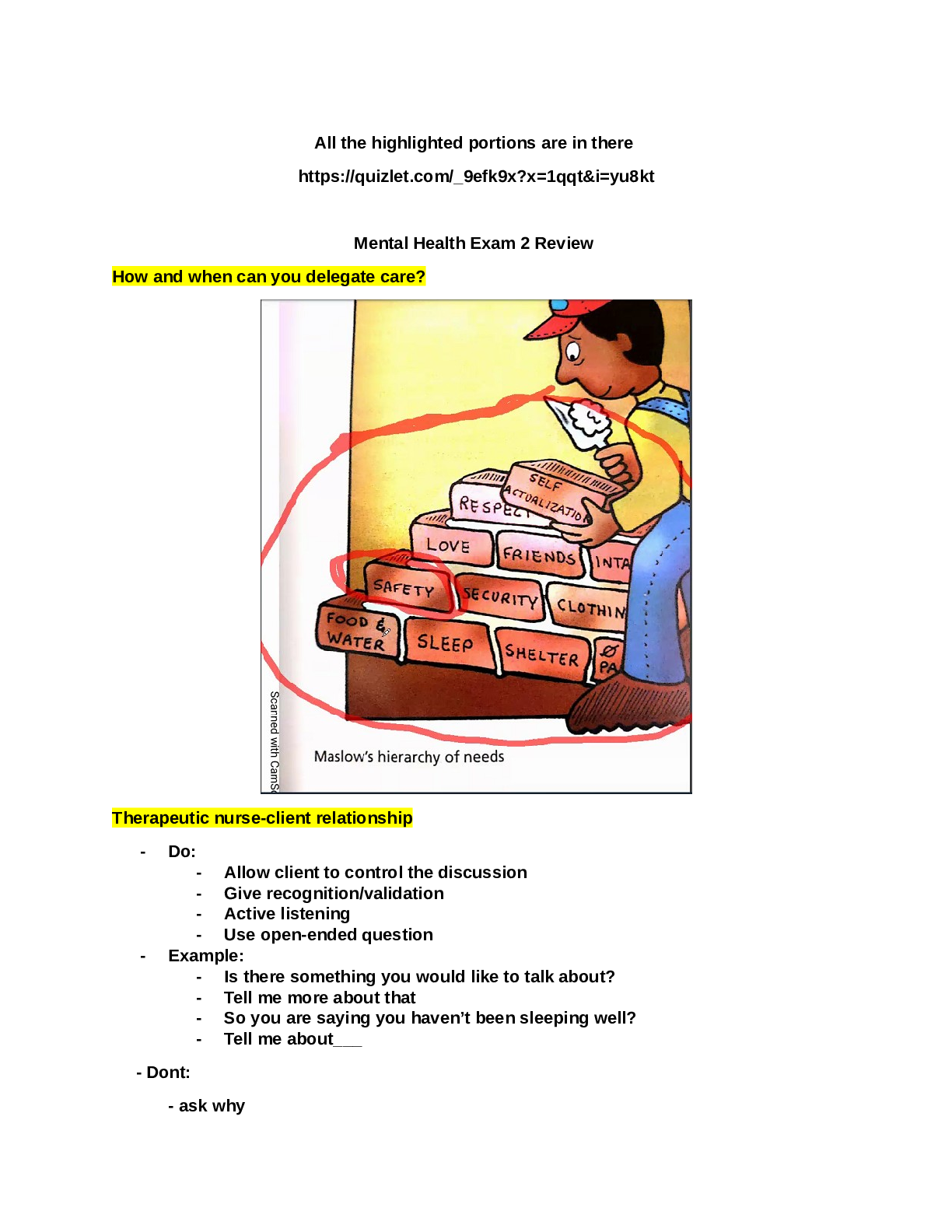
.png)

